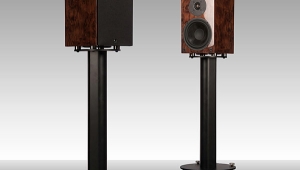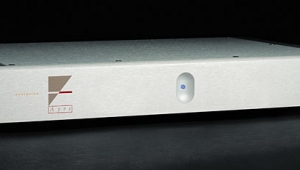| Columns Retired Columns & Blogs |
The Fifth Element #15 Page 2
In addition to its aforementioned virtues, the Brinkmann is a very quiet amplifier, in terms of both lack of transistor rush at idle and retrieval of low-level musical detail. That is as good a place as any to start an investigation of its technical individualities.
Footnote 1: Skeptics well may question the utility of balanced design within an entirely self-contained power-amplifier chassis, given the robustness of the voltages delivered to the speakers, and that there is only one ground potential.
In theory, designing an integrated amplifier rather than separate pre- and power amplifiers allows the designer freedom to dictate all the relevant parameters of the interaction between the line stage and the power amplifier. However, in practice, the result is often not much different than if the designer had merely smooshed a preamp—one that must be able to make its own way in the wide world—into the same case with a power amp that could be expected to see all manner of inputs.
Designer Helmut Brinkmann takes a different approach. One might be tempted to call the Integrated a "clean sheet of paper" design, but that might be an understatement. A "long, quiet walk in the woods" design, perhaps.
The Integrated's power-amplifier section works as a fully complementary dual-differential amplifier. Rather than having hot and ground as its outputs, the Brinkmann has phase and antiphase terminals. The speaker terminals are wonderful: thick, ergonomically shaped plastic grips that discourage the use of tools that might lead to overtightening, and beefy posts that accommodate hefty spades or banana plugs with no fuss and no Euro-nanny-ism. The only caveat to a truly balanced power amplifier output is that any kind of outboard speaker-switching device that has a common ground connection is a big no-no, because the Brinkmann's black terminals are not grounded.
Advocates of balanced circuit topography claim for it two principal sonic advantages: rejection of signals that are common to both phases (and therefore more likely to be noise of external origin), and isolation of the signal path from the unit's connection to ground. The concern about grounding is that in connecting, for example, a single-ended digital source to a single-ended preamplifier, and on to a single-ended power amplifier, each unit's chassis may have a slightly different ground potential, which will result in current flow along the differential. Half the signal is carried along the ground legs of the interconnects, so the added chassis-ground current should be expected to add noise.
Well then, you may ask, if balanced design is so great, why doesn't everyone use it? First, not everyone agrees that it's the optimum solution (footnote 1). Second, having two active signal paths nearly doubles the parts count and cost. And third, implementing a balanced amplifier design using single-ended inputs requires that at some point the input signal be split and one leg inverted. This is accomplished actively or, as is often the case, passively, through a transformer. At that point, those not persuaded to join the balanced camp have their "Ah-ha!" moment.
Obviously, running the signal through a transformer before amplification means that any departures from linearity on the part of the transformer will leave their fingerprints all over the signal as it gets amplified. Experienced listeners who are well-informed persons of good will may reasonably disagree whether the sound many associate with input-transformer-coupled designs is more accurate (in that it lacks added noise) or more euphonic (in that the transformer acts as a filter). The same disagreement appears in the world of professional sound recording, except that the subject is usually transformer-coupled microphones or microphone preamplifiers.
I am more interested in results than in recipes. Seeing as I place the Brinkmann on a tonal continuum between the Plinius, which is single-ended, and the Rowland Concentra II, which is balanced and transformer-coupled, it's fair to conclude that I didn't find the Brinkmann additively or subtractively colored to any noticeable degree. It just sounded good.
But Brinkmann's recipe is nonetheless unique, as far as I know. All its analog inputs are single-ended. Its line stage is passive. It is there that Brinkmann takes advantage of the freedom that controlling both sides of that interface confers. He can tailor the gain of the power amplifier, knowing in advance that the line stage is passive. The line stage also incorporates the transformer that accomplishes the signal split and inverts one leg for balanced amplification. As far as I know, Brinkmann's Integrated is the only integrated amplifier that combines a passive input stage with transformer-coupled balanced operation.
I think the sonic results speak for themselves, but it's reassuring to look back at the design brief and be able to nod sagely and say, "Yes, of course. Short signal paths, high gain, and transformer coupling to keep extraneous noise from being amplified. Case closed."
In a sense. In another sense, the case is always open, in that Brinkmann uses a piece of tempered glass as the top panel of the Integrated's case. This allows indicator lights to be placed next to that which they indicate. (It also shows off the high quality of the components and construction.) The input selector legends are under the glass as well, on the part of the selector knob barrel that passes through the faceplate. Operational functions are controlled by microprocessors, and the volume control is optically coupled.
Footnote 1: Skeptics well may question the utility of balanced design within an entirely self-contained power-amplifier chassis, given the robustness of the voltages delivered to the speakers, and that there is only one ground potential.
- Log in or register to post comments




































